Nursing Case Study: Patho-physiology, Investigations, Pharmacology
VerifiedAdded on 2023/06/14
|13
|3177
|71
AI Summary
This nursing case study discusses the patho-physiology, investigations, and pharmacology of a patient suffering from acute pulmonary oedema due to congestive heart failure. The patient's symptoms, medical history, and risk factors are analyzed to determine the underlying cause of the condition. Investigative assessments such as arterial blood gas assessment and 12 lead ECG are recommended. Pharmacological interventions such as diuretic lasix are discussed to reduce fluid overload and blood back up, and improve oxygenation.
Contribute Materials
Your contribution can guide someone’s learning journey. Share your
documents today.
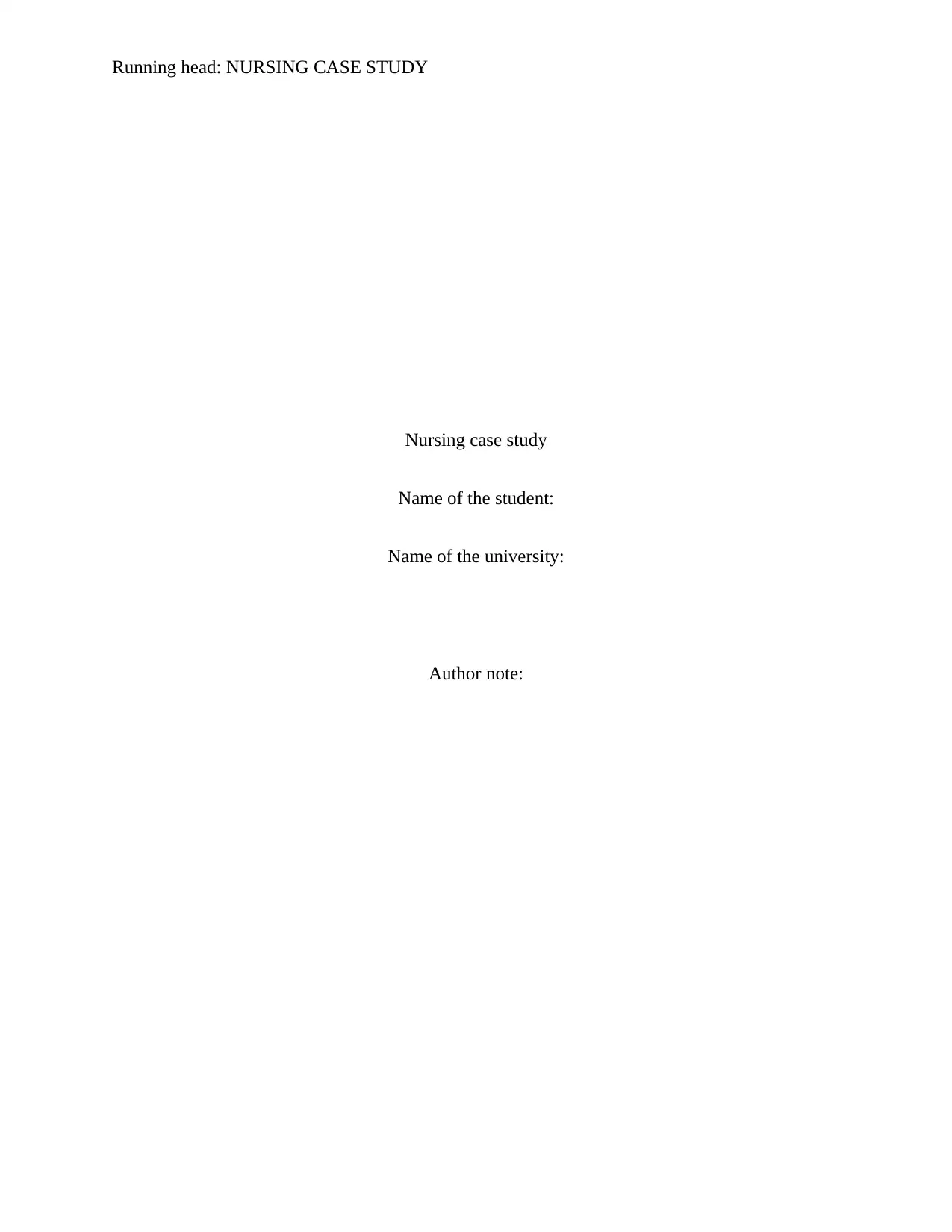
Running head: NURSING CASE STUDY
Nursing case study
Name of the student:
Name of the university:
Author note:
Nursing case study
Name of the student:
Name of the university:
Author note:
Secure Best Marks with AI Grader
Need help grading? Try our AI Grader for instant feedback on your assignments.
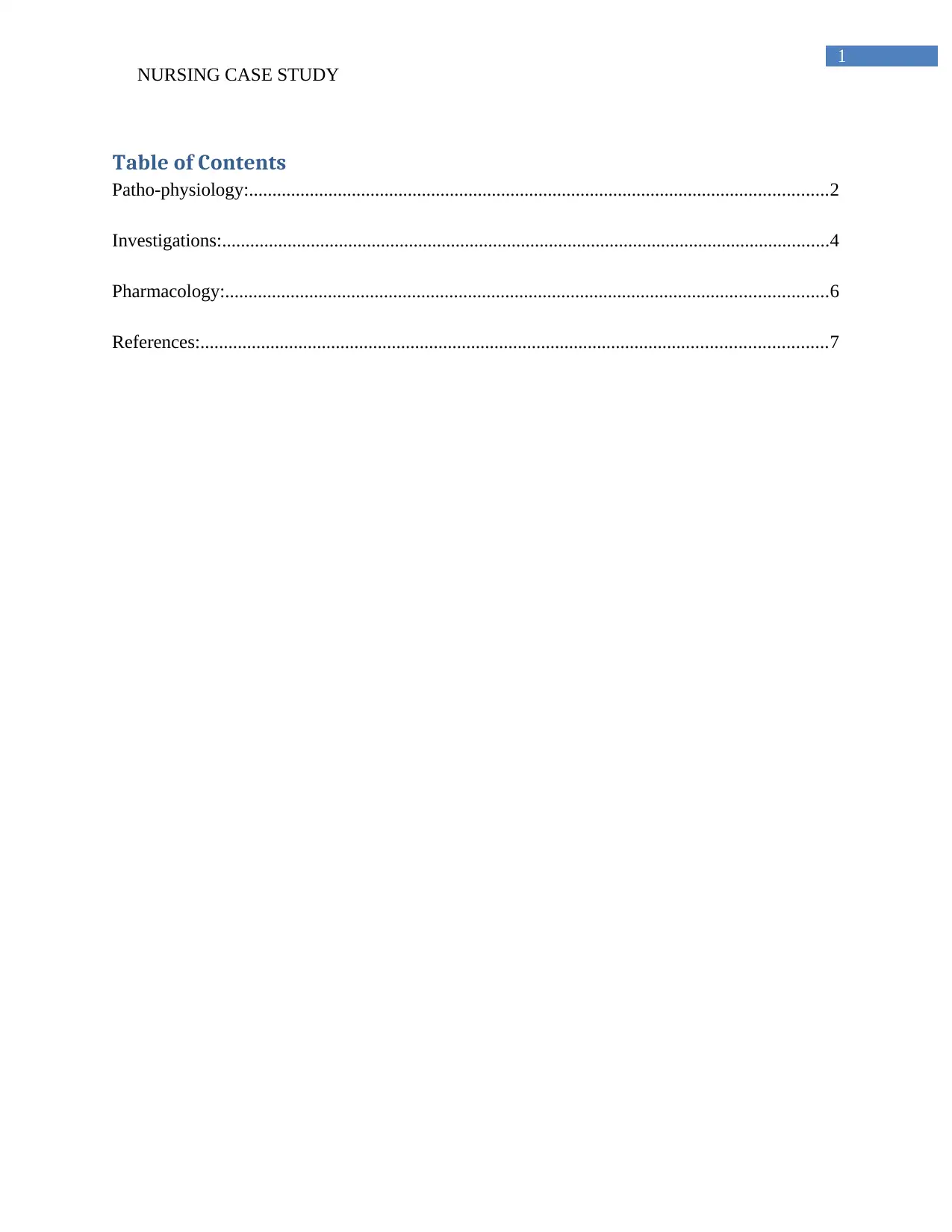
1
NURSING CASE STUDY
Table of Contents
Patho-physiology:............................................................................................................................2
Investigations:..................................................................................................................................4
Pharmacology:.................................................................................................................................6
References:......................................................................................................................................7
NURSING CASE STUDY
Table of Contents
Patho-physiology:............................................................................................................................2
Investigations:..................................................................................................................................4
Pharmacology:.................................................................................................................................6
References:......................................................................................................................................7
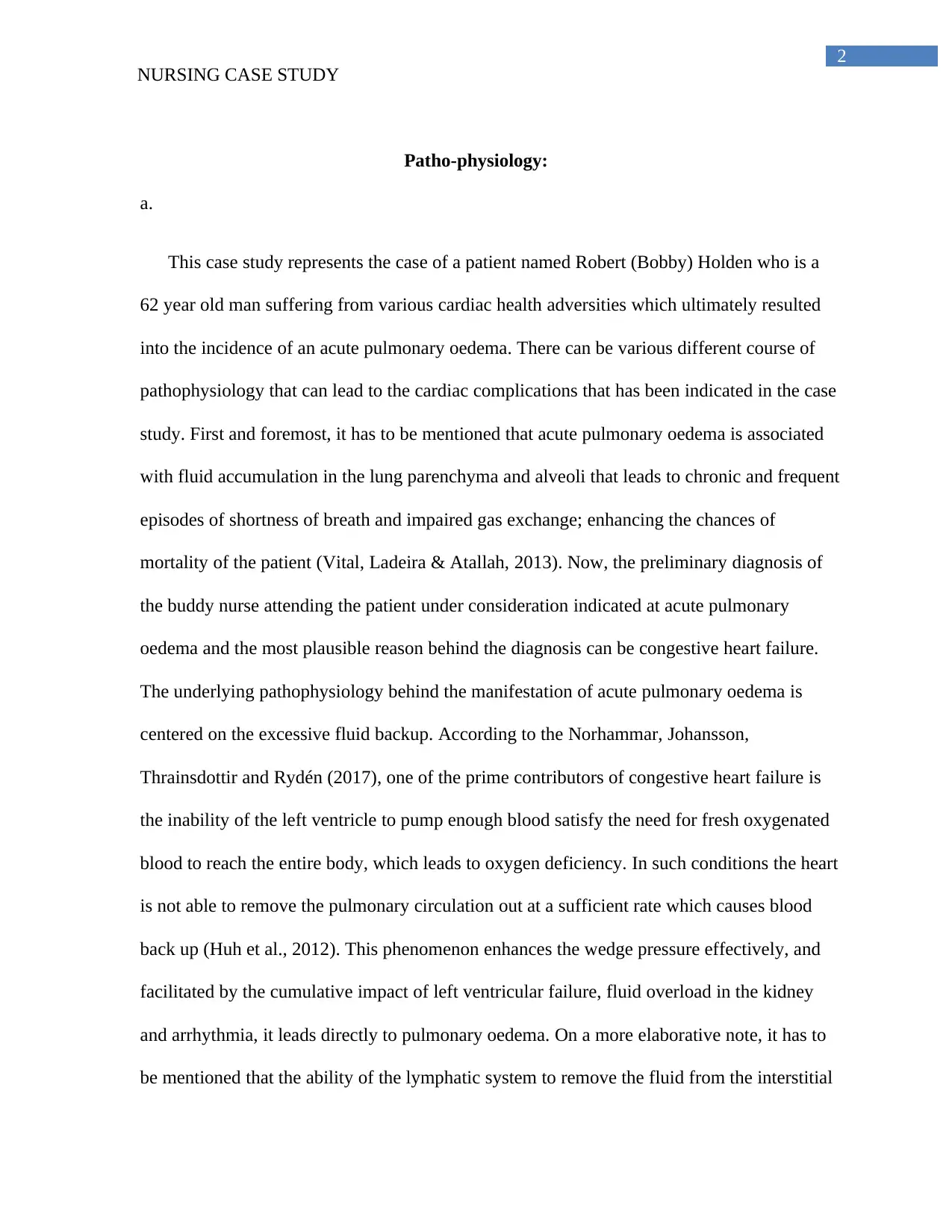
2
NURSING CASE STUDY
Patho-physiology:
a.
This case study represents the case of a patient named Robert (Bobby) Holden who is a
62 year old man suffering from various cardiac health adversities which ultimately resulted
into the incidence of an acute pulmonary oedema. There can be various different course of
pathophysiology that can lead to the cardiac complications that has been indicated in the case
study. First and foremost, it has to be mentioned that acute pulmonary oedema is associated
with fluid accumulation in the lung parenchyma and alveoli that leads to chronic and frequent
episodes of shortness of breath and impaired gas exchange; enhancing the chances of
mortality of the patient (Vital, Ladeira & Atallah, 2013). Now, the preliminary diagnosis of
the buddy nurse attending the patient under consideration indicated at acute pulmonary
oedema and the most plausible reason behind the diagnosis can be congestive heart failure.
The underlying pathophysiology behind the manifestation of acute pulmonary oedema is
centered on the excessive fluid backup. According to the Norhammar, Johansson,
Thrainsdottir and Rydén (2017), one of the prime contributors of congestive heart failure is
the inability of the left ventricle to pump enough blood satisfy the need for fresh oxygenated
blood to reach the entire body, which leads to oxygen deficiency. In such conditions the heart
is not able to remove the pulmonary circulation out at a sufficient rate which causes blood
back up (Huh et al., 2012). This phenomenon enhances the wedge pressure effectively, and
facilitated by the cumulative impact of left ventricular failure, fluid overload in the kidney
and arrhythmia, it leads directly to pulmonary oedema. On a more elaborative note, it has to
be mentioned that the ability of the lymphatic system to remove the fluid from the interstitial
NURSING CASE STUDY
Patho-physiology:
a.
This case study represents the case of a patient named Robert (Bobby) Holden who is a
62 year old man suffering from various cardiac health adversities which ultimately resulted
into the incidence of an acute pulmonary oedema. There can be various different course of
pathophysiology that can lead to the cardiac complications that has been indicated in the case
study. First and foremost, it has to be mentioned that acute pulmonary oedema is associated
with fluid accumulation in the lung parenchyma and alveoli that leads to chronic and frequent
episodes of shortness of breath and impaired gas exchange; enhancing the chances of
mortality of the patient (Vital, Ladeira & Atallah, 2013). Now, the preliminary diagnosis of
the buddy nurse attending the patient under consideration indicated at acute pulmonary
oedema and the most plausible reason behind the diagnosis can be congestive heart failure.
The underlying pathophysiology behind the manifestation of acute pulmonary oedema is
centered on the excessive fluid backup. According to the Norhammar, Johansson,
Thrainsdottir and Rydén (2017), one of the prime contributors of congestive heart failure is
the inability of the left ventricle to pump enough blood satisfy the need for fresh oxygenated
blood to reach the entire body, which leads to oxygen deficiency. In such conditions the heart
is not able to remove the pulmonary circulation out at a sufficient rate which causes blood
back up (Huh et al., 2012). This phenomenon enhances the wedge pressure effectively, and
facilitated by the cumulative impact of left ventricular failure, fluid overload in the kidney
and arrhythmia, it leads directly to pulmonary oedema. On a more elaborative note, it has to
be mentioned that the ability of the lymphatic system to remove the fluid from the interstitial
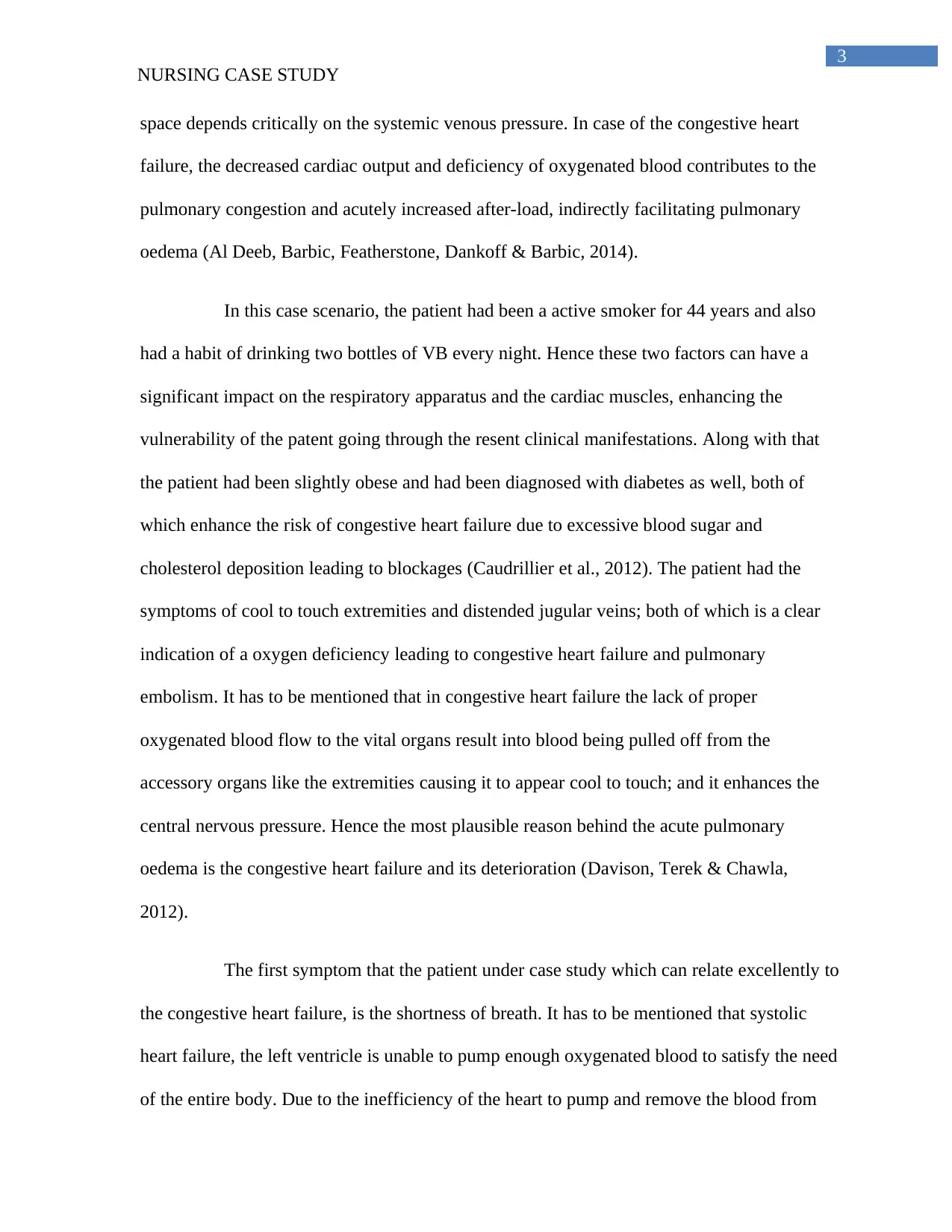
3
NURSING CASE STUDY
space depends critically on the systemic venous pressure. In case of the congestive heart
failure, the decreased cardiac output and deficiency of oxygenated blood contributes to the
pulmonary congestion and acutely increased after-load, indirectly facilitating pulmonary
oedema (Al Deeb, Barbic, Featherstone, Dankoff & Barbic, 2014).
In this case scenario, the patient had been a active smoker for 44 years and also
had a habit of drinking two bottles of VB every night. Hence these two factors can have a
significant impact on the respiratory apparatus and the cardiac muscles, enhancing the
vulnerability of the patent going through the resent clinical manifestations. Along with that
the patient had been slightly obese and had been diagnosed with diabetes as well, both of
which enhance the risk of congestive heart failure due to excessive blood sugar and
cholesterol deposition leading to blockages (Caudrillier et al., 2012). The patient had the
symptoms of cool to touch extremities and distended jugular veins; both of which is a clear
indication of a oxygen deficiency leading to congestive heart failure and pulmonary
embolism. It has to be mentioned that in congestive heart failure the lack of proper
oxygenated blood flow to the vital organs result into blood being pulled off from the
accessory organs like the extremities causing it to appear cool to touch; and it enhances the
central nervous pressure. Hence the most plausible reason behind the acute pulmonary
oedema is the congestive heart failure and its deterioration (Davison, Terek & Chawla,
2012).
The first symptom that the patient under case study which can relate excellently to
the congestive heart failure, is the shortness of breath. It has to be mentioned that systolic
heart failure, the left ventricle is unable to pump enough oxygenated blood to satisfy the need
of the entire body. Due to the inefficiency of the heart to pump and remove the blood from
NURSING CASE STUDY
space depends critically on the systemic venous pressure. In case of the congestive heart
failure, the decreased cardiac output and deficiency of oxygenated blood contributes to the
pulmonary congestion and acutely increased after-load, indirectly facilitating pulmonary
oedema (Al Deeb, Barbic, Featherstone, Dankoff & Barbic, 2014).
In this case scenario, the patient had been a active smoker for 44 years and also
had a habit of drinking two bottles of VB every night. Hence these two factors can have a
significant impact on the respiratory apparatus and the cardiac muscles, enhancing the
vulnerability of the patent going through the resent clinical manifestations. Along with that
the patient had been slightly obese and had been diagnosed with diabetes as well, both of
which enhance the risk of congestive heart failure due to excessive blood sugar and
cholesterol deposition leading to blockages (Caudrillier et al., 2012). The patient had the
symptoms of cool to touch extremities and distended jugular veins; both of which is a clear
indication of a oxygen deficiency leading to congestive heart failure and pulmonary
embolism. It has to be mentioned that in congestive heart failure the lack of proper
oxygenated blood flow to the vital organs result into blood being pulled off from the
accessory organs like the extremities causing it to appear cool to touch; and it enhances the
central nervous pressure. Hence the most plausible reason behind the acute pulmonary
oedema is the congestive heart failure and its deterioration (Davison, Terek & Chawla,
2012).
The first symptom that the patient under case study which can relate excellently to
the congestive heart failure, is the shortness of breath. It has to be mentioned that systolic
heart failure, the left ventricle is unable to pump enough oxygenated blood to satisfy the need
of the entire body. Due to the inefficiency of the heart to pump and remove the blood from
Secure Best Marks with AI Grader
Need help grading? Try our AI Grader for instant feedback on your assignments.
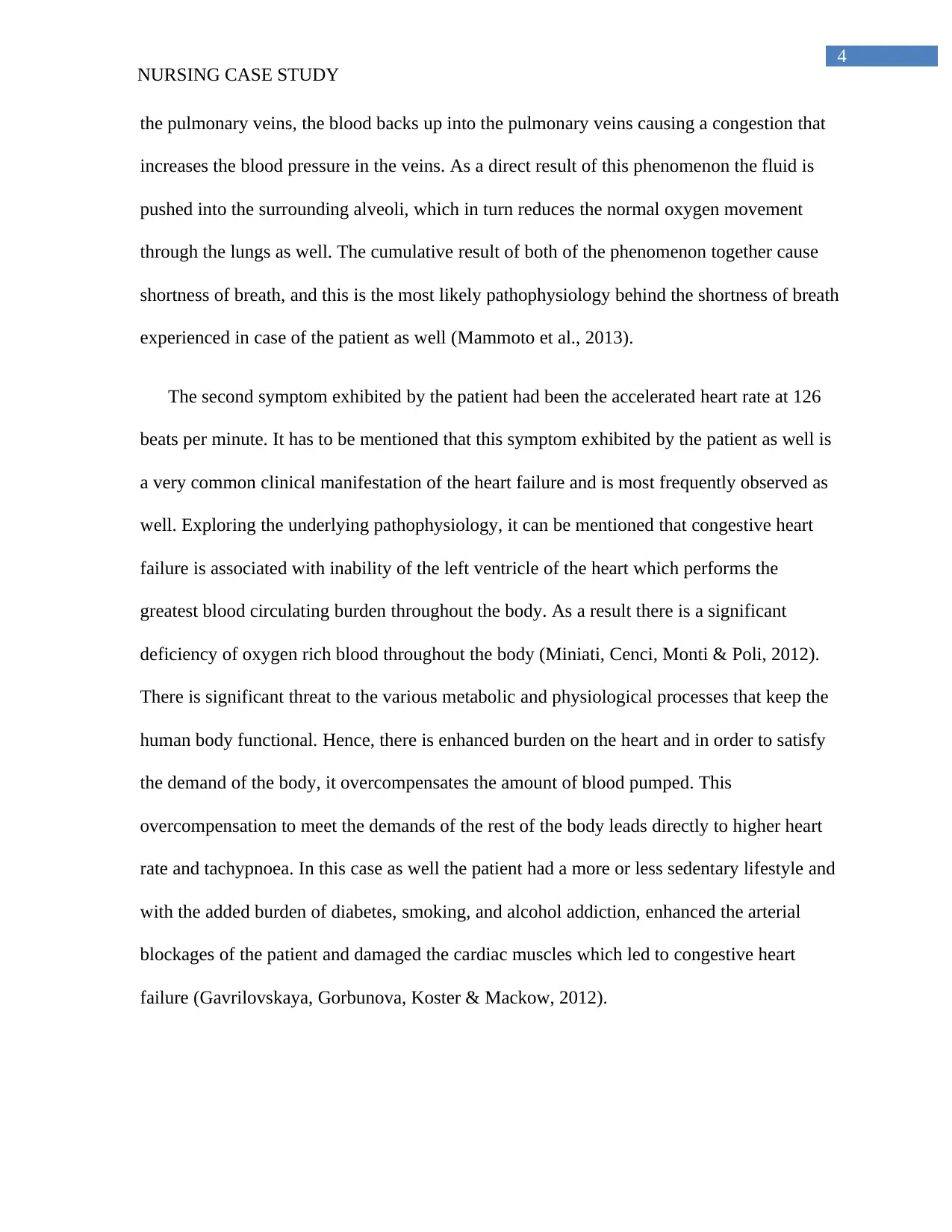
4
NURSING CASE STUDY
the pulmonary veins, the blood backs up into the pulmonary veins causing a congestion that
increases the blood pressure in the veins. As a direct result of this phenomenon the fluid is
pushed into the surrounding alveoli, which in turn reduces the normal oxygen movement
through the lungs as well. The cumulative result of both of the phenomenon together cause
shortness of breath, and this is the most likely pathophysiology behind the shortness of breath
experienced in case of the patient as well (Mammoto et al., 2013).
The second symptom exhibited by the patient had been the accelerated heart rate at 126
beats per minute. It has to be mentioned that this symptom exhibited by the patient as well is
a very common clinical manifestation of the heart failure and is most frequently observed as
well. Exploring the underlying pathophysiology, it can be mentioned that congestive heart
failure is associated with inability of the left ventricle of the heart which performs the
greatest blood circulating burden throughout the body. As a result there is a significant
deficiency of oxygen rich blood throughout the body (Miniati, Cenci, Monti & Poli, 2012).
There is significant threat to the various metabolic and physiological processes that keep the
human body functional. Hence, there is enhanced burden on the heart and in order to satisfy
the demand of the body, it overcompensates the amount of blood pumped. This
overcompensation to meet the demands of the rest of the body leads directly to higher heart
rate and tachypnoea. In this case as well the patient had a more or less sedentary lifestyle and
with the added burden of diabetes, smoking, and alcohol addiction, enhanced the arterial
blockages of the patient and damaged the cardiac muscles which led to congestive heart
failure (Gavrilovskaya, Gorbunova, Koster & Mackow, 2012).
NURSING CASE STUDY
the pulmonary veins, the blood backs up into the pulmonary veins causing a congestion that
increases the blood pressure in the veins. As a direct result of this phenomenon the fluid is
pushed into the surrounding alveoli, which in turn reduces the normal oxygen movement
through the lungs as well. The cumulative result of both of the phenomenon together cause
shortness of breath, and this is the most likely pathophysiology behind the shortness of breath
experienced in case of the patient as well (Mammoto et al., 2013).
The second symptom exhibited by the patient had been the accelerated heart rate at 126
beats per minute. It has to be mentioned that this symptom exhibited by the patient as well is
a very common clinical manifestation of the heart failure and is most frequently observed as
well. Exploring the underlying pathophysiology, it can be mentioned that congestive heart
failure is associated with inability of the left ventricle of the heart which performs the
greatest blood circulating burden throughout the body. As a result there is a significant
deficiency of oxygen rich blood throughout the body (Miniati, Cenci, Monti & Poli, 2012).
There is significant threat to the various metabolic and physiological processes that keep the
human body functional. Hence, there is enhanced burden on the heart and in order to satisfy
the demand of the body, it overcompensates the amount of blood pumped. This
overcompensation to meet the demands of the rest of the body leads directly to higher heart
rate and tachypnoea. In this case as well the patient had a more or less sedentary lifestyle and
with the added burden of diabetes, smoking, and alcohol addiction, enhanced the arterial
blockages of the patient and damaged the cardiac muscles which led to congestive heart
failure (Gavrilovskaya, Gorbunova, Koster & Mackow, 2012).
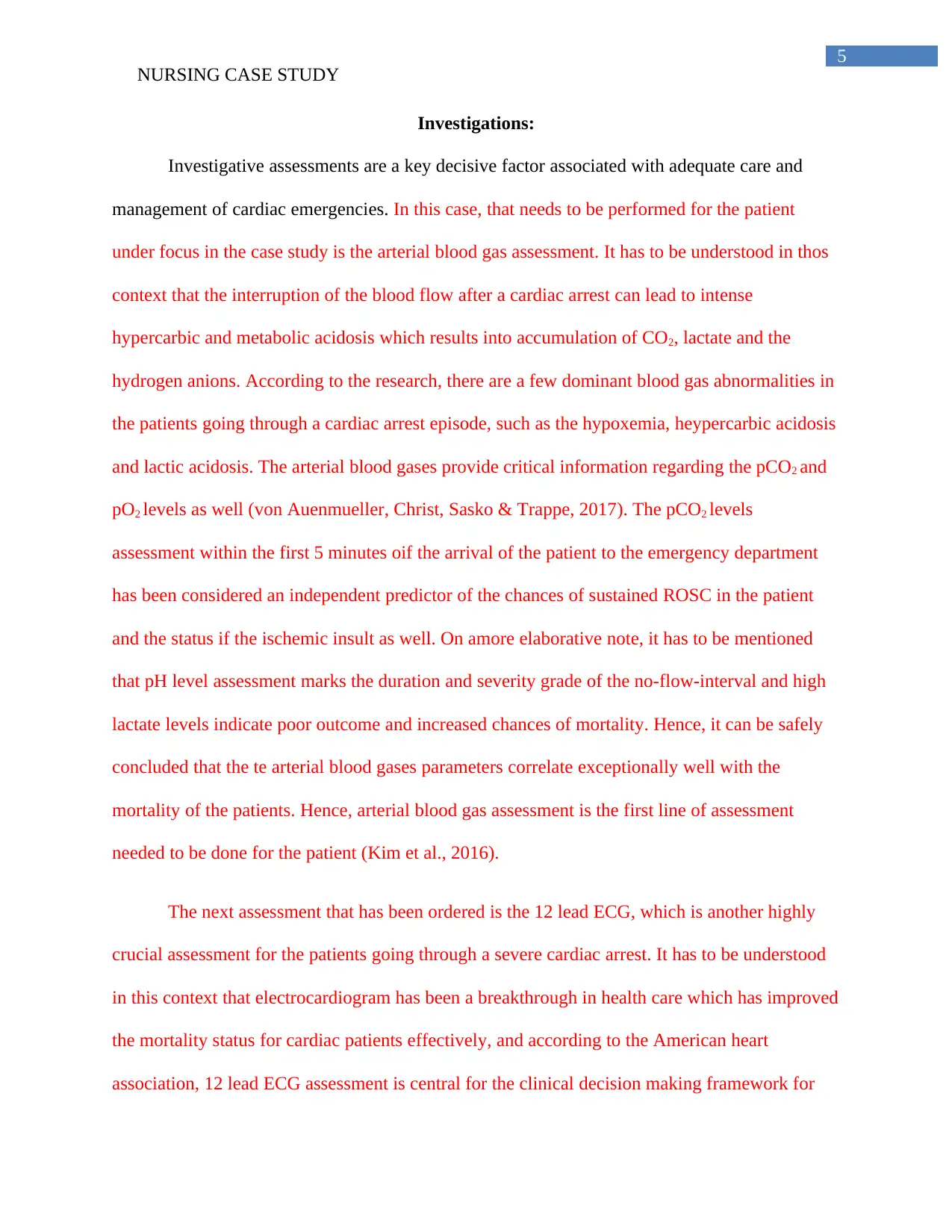
5
NURSING CASE STUDY
Investigations:
Investigative assessments are a key decisive factor associated with adequate care and
management of cardiac emergencies. In this case, that needs to be performed for the patient
under focus in the case study is the arterial blood gas assessment. It has to be understood in thos
context that the interruption of the blood flow after a cardiac arrest can lead to intense
hypercarbic and metabolic acidosis which results into accumulation of CO2, lactate and the
hydrogen anions. According to the research, there are a few dominant blood gas abnormalities in
the patients going through a cardiac arrest episode, such as the hypoxemia, heypercarbic acidosis
and lactic acidosis. The arterial blood gases provide critical information regarding the pCO2 and
pO2 levels as well (von Auenmueller, Christ, Sasko & Trappe, 2017). The pCO2 levels
assessment within the first 5 minutes oif the arrival of the patient to the emergency department
has been considered an independent predictor of the chances of sustained ROSC in the patient
and the status if the ischemic insult as well. On amore elaborative note, it has to be mentioned
that pH level assessment marks the duration and severity grade of the no-flow-interval and high
lactate levels indicate poor outcome and increased chances of mortality. Hence, it can be safely
concluded that the te arterial blood gases parameters correlate exceptionally well with the
mortality of the patients. Hence, arterial blood gas assessment is the first line of assessment
needed to be done for the patient (Kim et al., 2016).
The next assessment that has been ordered is the 12 lead ECG, which is another highly
crucial assessment for the patients going through a severe cardiac arrest. It has to be understood
in this context that electrocardiogram has been a breakthrough in health care which has improved
the mortality status for cardiac patients effectively, and according to the American heart
association, 12 lead ECG assessment is central for the clinical decision making framework for
NURSING CASE STUDY
Investigations:
Investigative assessments are a key decisive factor associated with adequate care and
management of cardiac emergencies. In this case, that needs to be performed for the patient
under focus in the case study is the arterial blood gas assessment. It has to be understood in thos
context that the interruption of the blood flow after a cardiac arrest can lead to intense
hypercarbic and metabolic acidosis which results into accumulation of CO2, lactate and the
hydrogen anions. According to the research, there are a few dominant blood gas abnormalities in
the patients going through a cardiac arrest episode, such as the hypoxemia, heypercarbic acidosis
and lactic acidosis. The arterial blood gases provide critical information regarding the pCO2 and
pO2 levels as well (von Auenmueller, Christ, Sasko & Trappe, 2017). The pCO2 levels
assessment within the first 5 minutes oif the arrival of the patient to the emergency department
has been considered an independent predictor of the chances of sustained ROSC in the patient
and the status if the ischemic insult as well. On amore elaborative note, it has to be mentioned
that pH level assessment marks the duration and severity grade of the no-flow-interval and high
lactate levels indicate poor outcome and increased chances of mortality. Hence, it can be safely
concluded that the te arterial blood gases parameters correlate exceptionally well with the
mortality of the patients. Hence, arterial blood gas assessment is the first line of assessment
needed to be done for the patient (Kim et al., 2016).
The next assessment that has been ordered is the 12 lead ECG, which is another highly
crucial assessment for the patients going through a severe cardiac arrest. It has to be understood
in this context that electrocardiogram has been a breakthrough in health care which has improved
the mortality status for cardiac patients effectively, and according to the American heart
association, 12 lead ECG assessment is central for the clinical decision making framework for
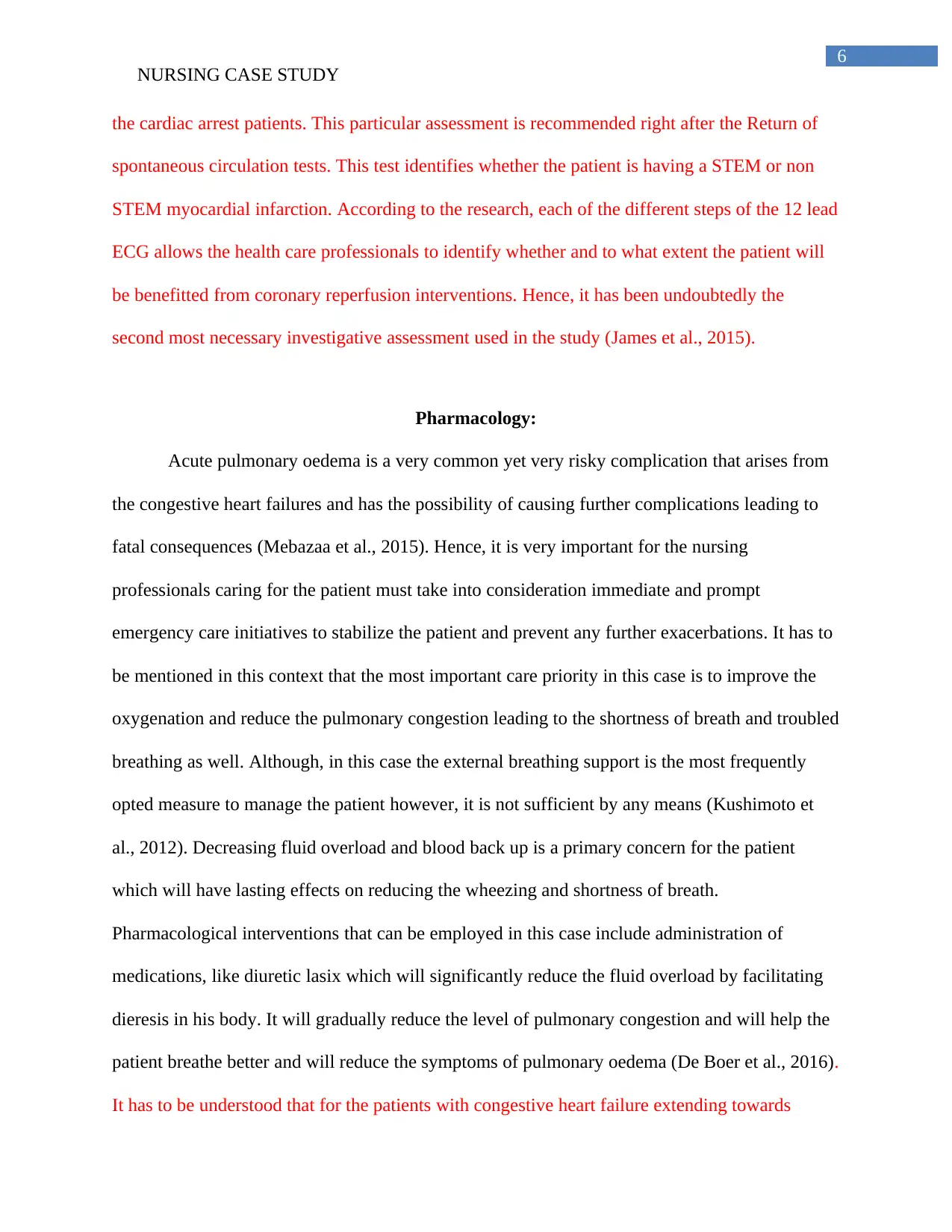
6
NURSING CASE STUDY
the cardiac arrest patients. This particular assessment is recommended right after the Return of
spontaneous circulation tests. This test identifies whether the patient is having a STEM or non
STEM myocardial infarction. According to the research, each of the different steps of the 12 lead
ECG allows the health care professionals to identify whether and to what extent the patient will
be benefitted from coronary reperfusion interventions. Hence, it has been undoubtedly the
second most necessary investigative assessment used in the study (James et al., 2015).
Pharmacology:
Acute pulmonary oedema is a very common yet very risky complication that arises from
the congestive heart failures and has the possibility of causing further complications leading to
fatal consequences (Mebazaa et al., 2015). Hence, it is very important for the nursing
professionals caring for the patient must take into consideration immediate and prompt
emergency care initiatives to stabilize the patient and prevent any further exacerbations. It has to
be mentioned in this context that the most important care priority in this case is to improve the
oxygenation and reduce the pulmonary congestion leading to the shortness of breath and troubled
breathing as well. Although, in this case the external breathing support is the most frequently
opted measure to manage the patient however, it is not sufficient by any means (Kushimoto et
al., 2012). Decreasing fluid overload and blood back up is a primary concern for the patient
which will have lasting effects on reducing the wheezing and shortness of breath.
Pharmacological interventions that can be employed in this case include administration of
medications, like diuretic lasix which will significantly reduce the fluid overload by facilitating
dieresis in his body. It will gradually reduce the level of pulmonary congestion and will help the
patient breathe better and will reduce the symptoms of pulmonary oedema (De Boer et al., 2016).
It has to be understood that for the patients with congestive heart failure extending towards
NURSING CASE STUDY
the cardiac arrest patients. This particular assessment is recommended right after the Return of
spontaneous circulation tests. This test identifies whether the patient is having a STEM or non
STEM myocardial infarction. According to the research, each of the different steps of the 12 lead
ECG allows the health care professionals to identify whether and to what extent the patient will
be benefitted from coronary reperfusion interventions. Hence, it has been undoubtedly the
second most necessary investigative assessment used in the study (James et al., 2015).
Pharmacology:
Acute pulmonary oedema is a very common yet very risky complication that arises from
the congestive heart failures and has the possibility of causing further complications leading to
fatal consequences (Mebazaa et al., 2015). Hence, it is very important for the nursing
professionals caring for the patient must take into consideration immediate and prompt
emergency care initiatives to stabilize the patient and prevent any further exacerbations. It has to
be mentioned in this context that the most important care priority in this case is to improve the
oxygenation and reduce the pulmonary congestion leading to the shortness of breath and troubled
breathing as well. Although, in this case the external breathing support is the most frequently
opted measure to manage the patient however, it is not sufficient by any means (Kushimoto et
al., 2012). Decreasing fluid overload and blood back up is a primary concern for the patient
which will have lasting effects on reducing the wheezing and shortness of breath.
Pharmacological interventions that can be employed in this case include administration of
medications, like diuretic lasix which will significantly reduce the fluid overload by facilitating
dieresis in his body. It will gradually reduce the level of pulmonary congestion and will help the
patient breathe better and will reduce the symptoms of pulmonary oedema (De Boer et al., 2016).
It has to be understood that for the patients with congestive heart failure extending towards
Paraphrase This Document
Need a fresh take? Get an instant paraphrase of this document with our AI Paraphraser
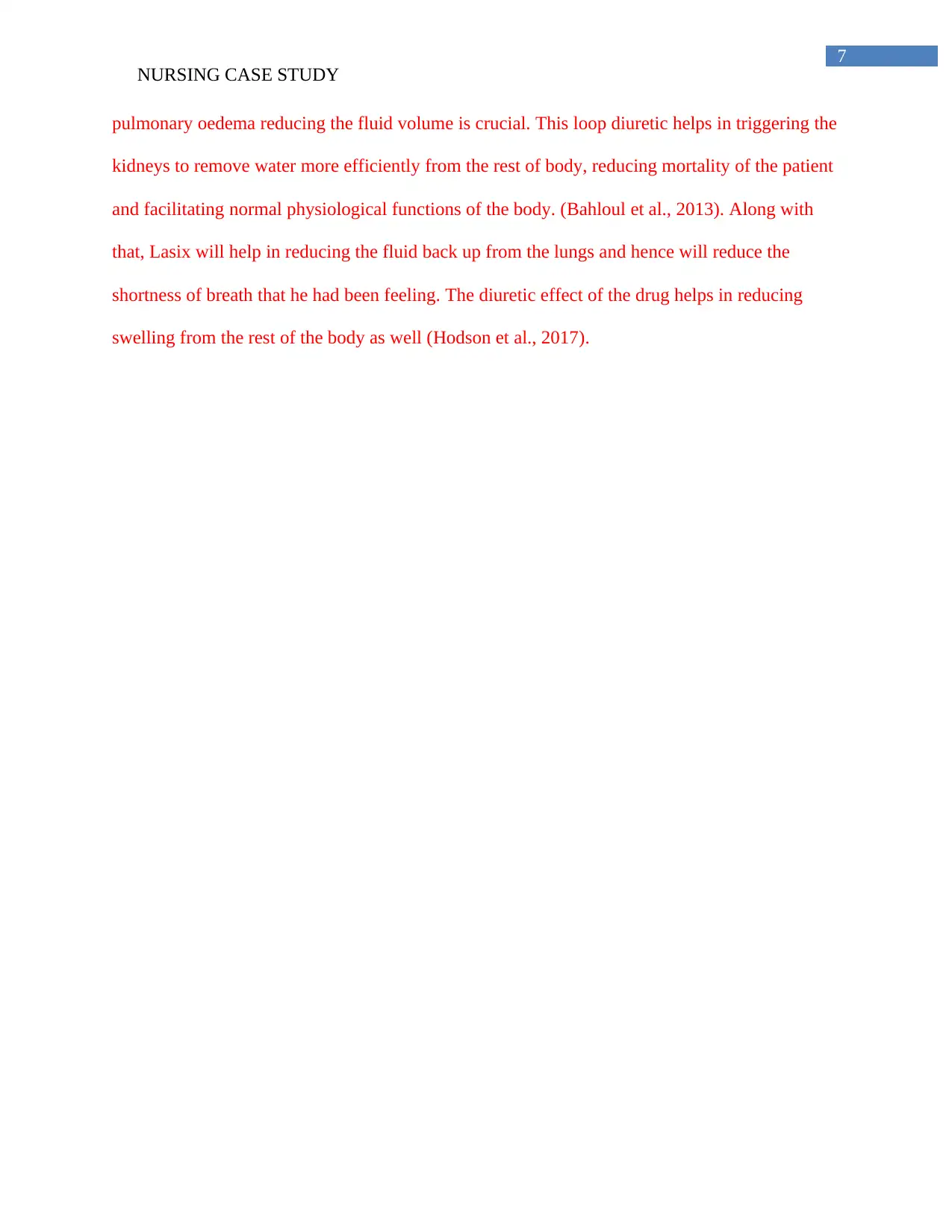
7
NURSING CASE STUDY
pulmonary oedema reducing the fluid volume is crucial. This loop diuretic helps in triggering the
kidneys to remove water more efficiently from the rest of body, reducing mortality of the patient
and facilitating normal physiological functions of the body. (Bahloul et al., 2013). Along with
that, Lasix will help in reducing the fluid back up from the lungs and hence will reduce the
shortness of breath that he had been feeling. The diuretic effect of the drug helps in reducing
swelling from the rest of the body as well (Hodson et al., 2017).
NURSING CASE STUDY
pulmonary oedema reducing the fluid volume is crucial. This loop diuretic helps in triggering the
kidneys to remove water more efficiently from the rest of body, reducing mortality of the patient
and facilitating normal physiological functions of the body. (Bahloul et al., 2013). Along with
that, Lasix will help in reducing the fluid back up from the lungs and hence will reduce the
shortness of breath that he had been feeling. The diuretic effect of the drug helps in reducing
swelling from the rest of the body as well (Hodson et al., 2017).
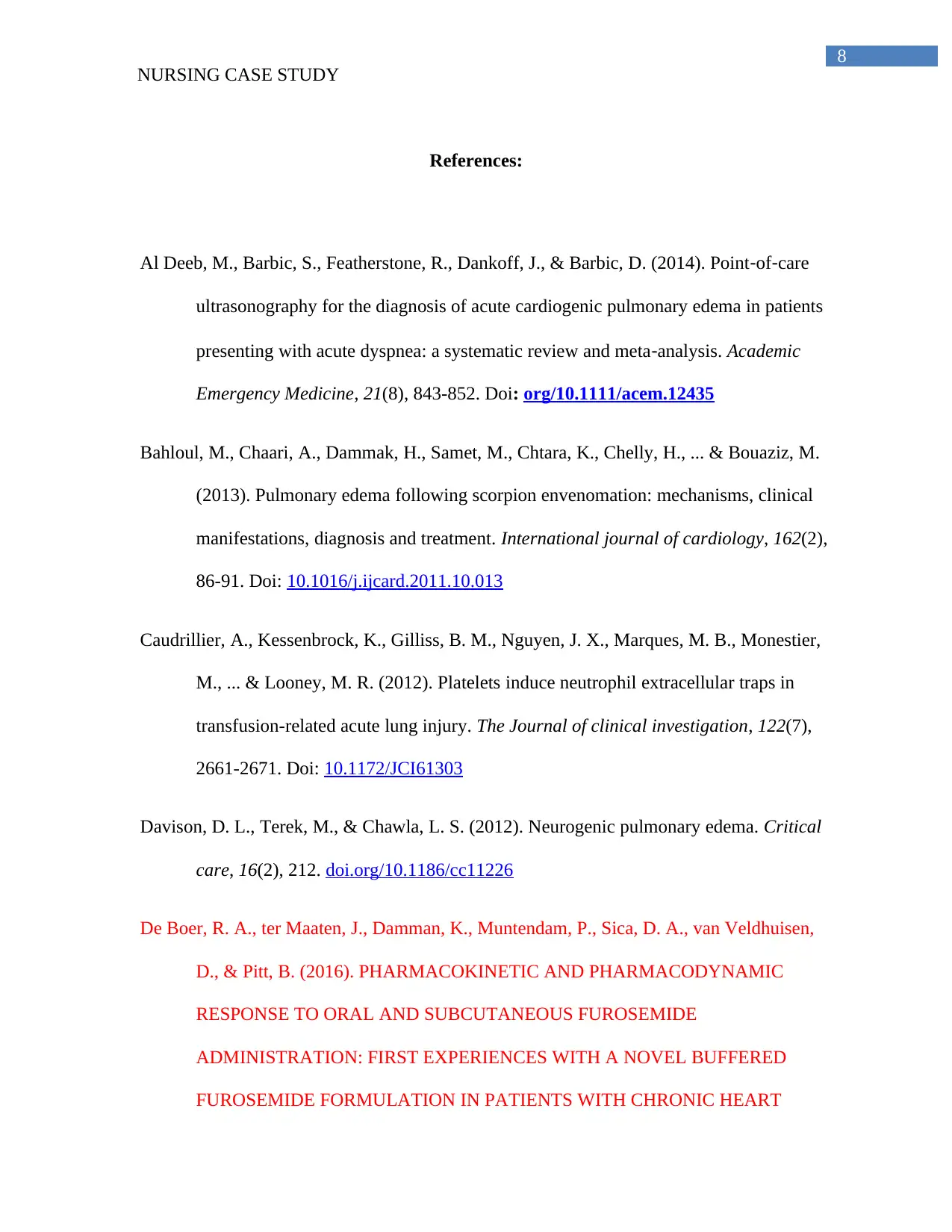
8
NURSING CASE STUDY
References:
Al Deeb, M., Barbic, S., Featherstone, R., Dankoff, J., & Barbic, D. (2014). Point‐of‐care
ultrasonography for the diagnosis of acute cardiogenic pulmonary edema in patients
presenting with acute dyspnea: a systematic review and meta‐analysis. Academic
Emergency Medicine, 21(8), 843-852. Doi: org/10.1111/acem.12435
Bahloul, M., Chaari, A., Dammak, H., Samet, M., Chtara, K., Chelly, H., ... & Bouaziz, M.
(2013). Pulmonary edema following scorpion envenomation: mechanisms, clinical
manifestations, diagnosis and treatment. International journal of cardiology, 162(2),
86-91. Doi: 10.1016/j.ijcard.2011.10.013
Caudrillier, A., Kessenbrock, K., Gilliss, B. M., Nguyen, J. X., Marques, M. B., Monestier,
M., ... & Looney, M. R. (2012). Platelets induce neutrophil extracellular traps in
transfusion-related acute lung injury. The Journal of clinical investigation, 122(7),
2661-2671. Doi: 10.1172/JCI61303
Davison, D. L., Terek, M., & Chawla, L. S. (2012). Neurogenic pulmonary edema. Critical
care, 16(2), 212. doi.org/10.1186/cc11226
De Boer, R. A., ter Maaten, J., Damman, K., Muntendam, P., Sica, D. A., van Veldhuisen,
D., & Pitt, B. (2016). PHARMACOKINETIC AND PHARMACODYNAMIC
RESPONSE TO ORAL AND SUBCUTANEOUS FUROSEMIDE
ADMINISTRATION: FIRST EXPERIENCES WITH A NOVEL BUFFERED
FUROSEMIDE FORMULATION IN PATIENTS WITH CHRONIC HEART
NURSING CASE STUDY
References:
Al Deeb, M., Barbic, S., Featherstone, R., Dankoff, J., & Barbic, D. (2014). Point‐of‐care
ultrasonography for the diagnosis of acute cardiogenic pulmonary edema in patients
presenting with acute dyspnea: a systematic review and meta‐analysis. Academic
Emergency Medicine, 21(8), 843-852. Doi: org/10.1111/acem.12435
Bahloul, M., Chaari, A., Dammak, H., Samet, M., Chtara, K., Chelly, H., ... & Bouaziz, M.
(2013). Pulmonary edema following scorpion envenomation: mechanisms, clinical
manifestations, diagnosis and treatment. International journal of cardiology, 162(2),
86-91. Doi: 10.1016/j.ijcard.2011.10.013
Caudrillier, A., Kessenbrock, K., Gilliss, B. M., Nguyen, J. X., Marques, M. B., Monestier,
M., ... & Looney, M. R. (2012). Platelets induce neutrophil extracellular traps in
transfusion-related acute lung injury. The Journal of clinical investigation, 122(7),
2661-2671. Doi: 10.1172/JCI61303
Davison, D. L., Terek, M., & Chawla, L. S. (2012). Neurogenic pulmonary edema. Critical
care, 16(2), 212. doi.org/10.1186/cc11226
De Boer, R. A., ter Maaten, J., Damman, K., Muntendam, P., Sica, D. A., van Veldhuisen,
D., & Pitt, B. (2016). PHARMACOKINETIC AND PHARMACODYNAMIC
RESPONSE TO ORAL AND SUBCUTANEOUS FUROSEMIDE
ADMINISTRATION: FIRST EXPERIENCES WITH A NOVEL BUFFERED
FUROSEMIDE FORMULATION IN PATIENTS WITH CHRONIC HEART
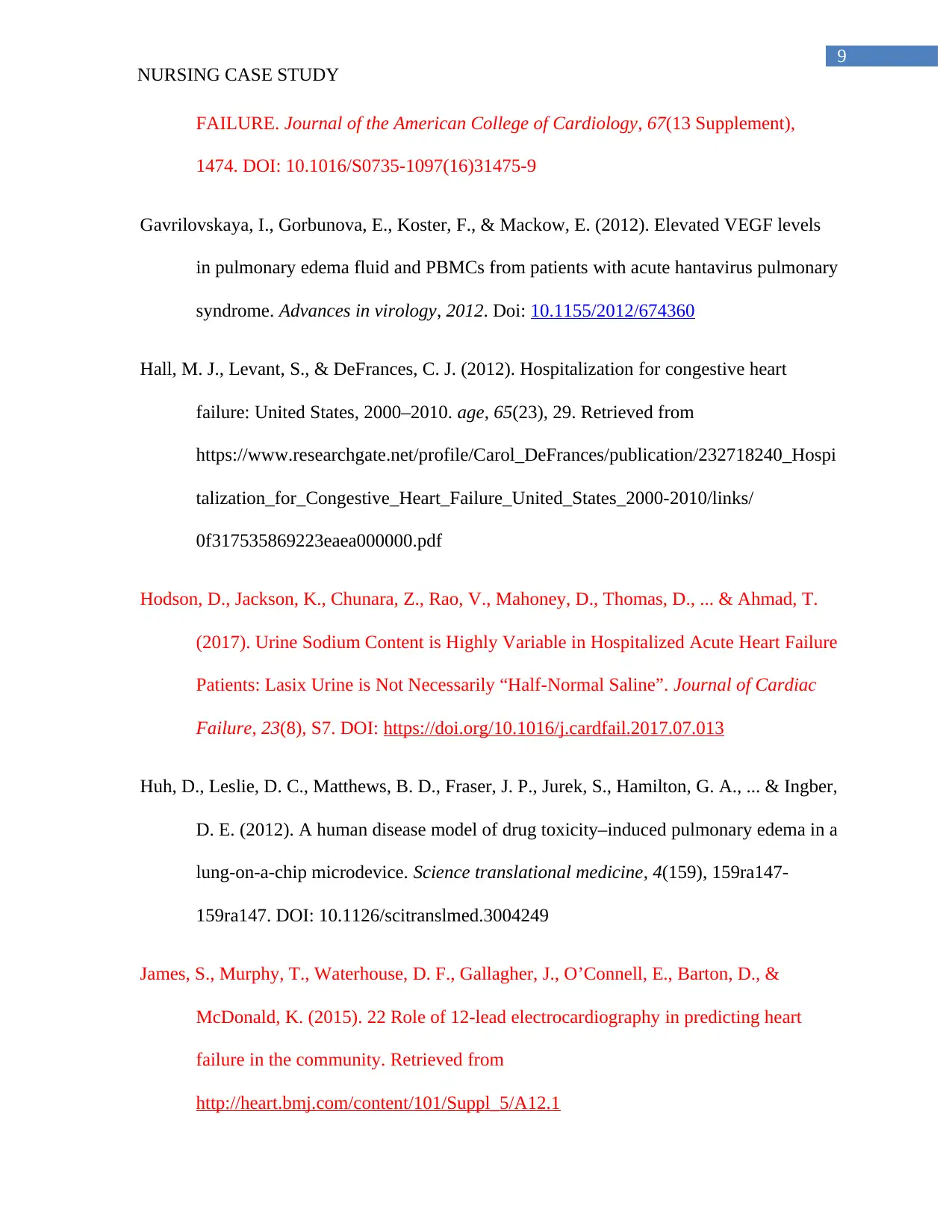
9
NURSING CASE STUDY
FAILURE. Journal of the American College of Cardiology, 67(13 Supplement),
1474. DOI: 10.1016/S0735-1097(16)31475-9
Gavrilovskaya, I., Gorbunova, E., Koster, F., & Mackow, E. (2012). Elevated VEGF levels
in pulmonary edema fluid and PBMCs from patients with acute hantavirus pulmonary
syndrome. Advances in virology, 2012. Doi: 10.1155/2012/674360
Hall, M. J., Levant, S., & DeFrances, C. J. (2012). Hospitalization for congestive heart
failure: United States, 2000–2010. age, 65(23), 29. Retrieved from
https://www.researchgate.net/profile/Carol_DeFrances/publication/232718240_Hospi
talization_for_Congestive_Heart_Failure_United_States_2000-2010/links/
0f317535869223eaea000000.pdf
Hodson, D., Jackson, K., Chunara, Z., Rao, V., Mahoney, D., Thomas, D., ... & Ahmad, T.
(2017). Urine Sodium Content is Highly Variable in Hospitalized Acute Heart Failure
Patients: Lasix Urine is Not Necessarily “Half-Normal Saline”. Journal of Cardiac
Failure, 23(8), S7. DOI: https://doi.org/10.1016/j.cardfail.2017.07.013
Huh, D., Leslie, D. C., Matthews, B. D., Fraser, J. P., Jurek, S., Hamilton, G. A., ... & Ingber,
D. E. (2012). A human disease model of drug toxicity–induced pulmonary edema in a
lung-on-a-chip microdevice. Science translational medicine, 4(159), 159ra147-
159ra147. DOI: 10.1126/scitranslmed.3004249
James, S., Murphy, T., Waterhouse, D. F., Gallagher, J., O’Connell, E., Barton, D., &
McDonald, K. (2015). 22 Role of 12-lead electrocardiography in predicting heart
failure in the community. Retrieved from
http://heart.bmj.com/content/101/Suppl_5/A12.1
NURSING CASE STUDY
FAILURE. Journal of the American College of Cardiology, 67(13 Supplement),
1474. DOI: 10.1016/S0735-1097(16)31475-9
Gavrilovskaya, I., Gorbunova, E., Koster, F., & Mackow, E. (2012). Elevated VEGF levels
in pulmonary edema fluid and PBMCs from patients with acute hantavirus pulmonary
syndrome. Advances in virology, 2012. Doi: 10.1155/2012/674360
Hall, M. J., Levant, S., & DeFrances, C. J. (2012). Hospitalization for congestive heart
failure: United States, 2000–2010. age, 65(23), 29. Retrieved from
https://www.researchgate.net/profile/Carol_DeFrances/publication/232718240_Hospi
talization_for_Congestive_Heart_Failure_United_States_2000-2010/links/
0f317535869223eaea000000.pdf
Hodson, D., Jackson, K., Chunara, Z., Rao, V., Mahoney, D., Thomas, D., ... & Ahmad, T.
(2017). Urine Sodium Content is Highly Variable in Hospitalized Acute Heart Failure
Patients: Lasix Urine is Not Necessarily “Half-Normal Saline”. Journal of Cardiac
Failure, 23(8), S7. DOI: https://doi.org/10.1016/j.cardfail.2017.07.013
Huh, D., Leslie, D. C., Matthews, B. D., Fraser, J. P., Jurek, S., Hamilton, G. A., ... & Ingber,
D. E. (2012). A human disease model of drug toxicity–induced pulmonary edema in a
lung-on-a-chip microdevice. Science translational medicine, 4(159), 159ra147-
159ra147. DOI: 10.1126/scitranslmed.3004249
James, S., Murphy, T., Waterhouse, D. F., Gallagher, J., O’Connell, E., Barton, D., &
McDonald, K. (2015). 22 Role of 12-lead electrocardiography in predicting heart
failure in the community. Retrieved from
http://heart.bmj.com/content/101/Suppl_5/A12.1
Secure Best Marks with AI Grader
Need help grading? Try our AI Grader for instant feedback on your assignments.
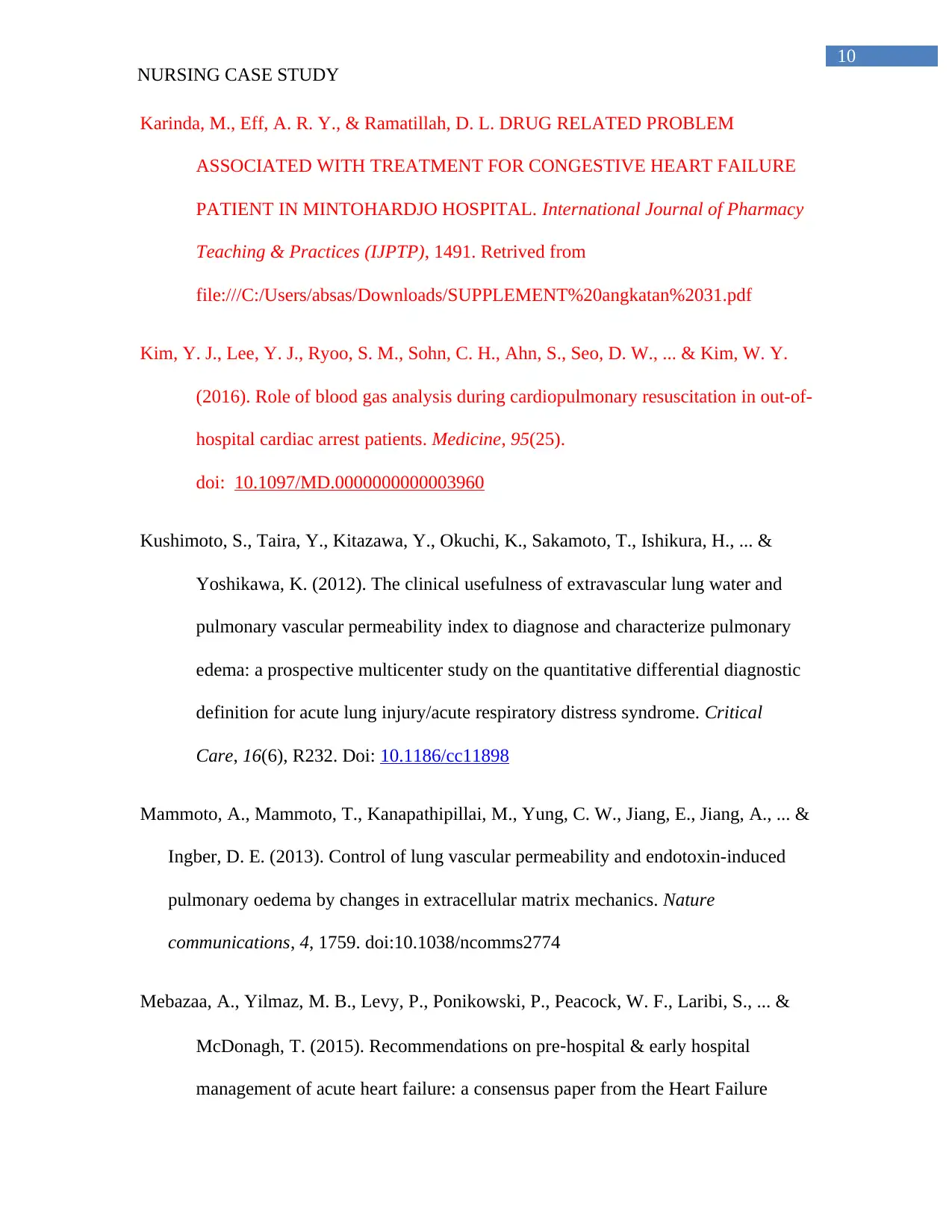
10
NURSING CASE STUDY
Karinda, M., Eff, A. R. Y., & Ramatillah, D. L. DRUG RELATED PROBLEM
ASSOCIATED WITH TREATMENT FOR CONGESTIVE HEART FAILURE
PATIENT IN MINTOHARDJO HOSPITAL. International Journal of Pharmacy
Teaching & Practices (IJPTP), 1491. Retrived from
file:///C:/Users/absas/Downloads/SUPPLEMENT%20angkatan%2031.pdf
Kim, Y. J., Lee, Y. J., Ryoo, S. M., Sohn, C. H., Ahn, S., Seo, D. W., ... & Kim, W. Y.
(2016). Role of blood gas analysis during cardiopulmonary resuscitation in out-of-
hospital cardiac arrest patients. Medicine, 95(25).
doi: 10.1097/MD.0000000000003960
Kushimoto, S., Taira, Y., Kitazawa, Y., Okuchi, K., Sakamoto, T., Ishikura, H., ... &
Yoshikawa, K. (2012). The clinical usefulness of extravascular lung water and
pulmonary vascular permeability index to diagnose and characterize pulmonary
edema: a prospective multicenter study on the quantitative differential diagnostic
definition for acute lung injury/acute respiratory distress syndrome. Critical
Care, 16(6), R232. Doi: 10.1186/cc11898
Mammoto, A., Mammoto, T., Kanapathipillai, M., Yung, C. W., Jiang, E., Jiang, A., ... &
Ingber, D. E. (2013). Control of lung vascular permeability and endotoxin-induced
pulmonary oedema by changes in extracellular matrix mechanics. Nature
communications, 4, 1759. doi:10.1038/ncomms2774
Mebazaa, A., Yilmaz, M. B., Levy, P., Ponikowski, P., Peacock, W. F., Laribi, S., ... &
McDonagh, T. (2015). Recommendations on pre‐hospital & early hospital
management of acute heart failure: a consensus paper from the Heart Failure
NURSING CASE STUDY
Karinda, M., Eff, A. R. Y., & Ramatillah, D. L. DRUG RELATED PROBLEM
ASSOCIATED WITH TREATMENT FOR CONGESTIVE HEART FAILURE
PATIENT IN MINTOHARDJO HOSPITAL. International Journal of Pharmacy
Teaching & Practices (IJPTP), 1491. Retrived from
file:///C:/Users/absas/Downloads/SUPPLEMENT%20angkatan%2031.pdf
Kim, Y. J., Lee, Y. J., Ryoo, S. M., Sohn, C. H., Ahn, S., Seo, D. W., ... & Kim, W. Y.
(2016). Role of blood gas analysis during cardiopulmonary resuscitation in out-of-
hospital cardiac arrest patients. Medicine, 95(25).
doi: 10.1097/MD.0000000000003960
Kushimoto, S., Taira, Y., Kitazawa, Y., Okuchi, K., Sakamoto, T., Ishikura, H., ... &
Yoshikawa, K. (2012). The clinical usefulness of extravascular lung water and
pulmonary vascular permeability index to diagnose and characterize pulmonary
edema: a prospective multicenter study on the quantitative differential diagnostic
definition for acute lung injury/acute respiratory distress syndrome. Critical
Care, 16(6), R232. Doi: 10.1186/cc11898
Mammoto, A., Mammoto, T., Kanapathipillai, M., Yung, C. W., Jiang, E., Jiang, A., ... &
Ingber, D. E. (2013). Control of lung vascular permeability and endotoxin-induced
pulmonary oedema by changes in extracellular matrix mechanics. Nature
communications, 4, 1759. doi:10.1038/ncomms2774
Mebazaa, A., Yilmaz, M. B., Levy, P., Ponikowski, P., Peacock, W. F., Laribi, S., ... &
McDonagh, T. (2015). Recommendations on pre‐hospital & early hospital
management of acute heart failure: a consensus paper from the Heart Failure
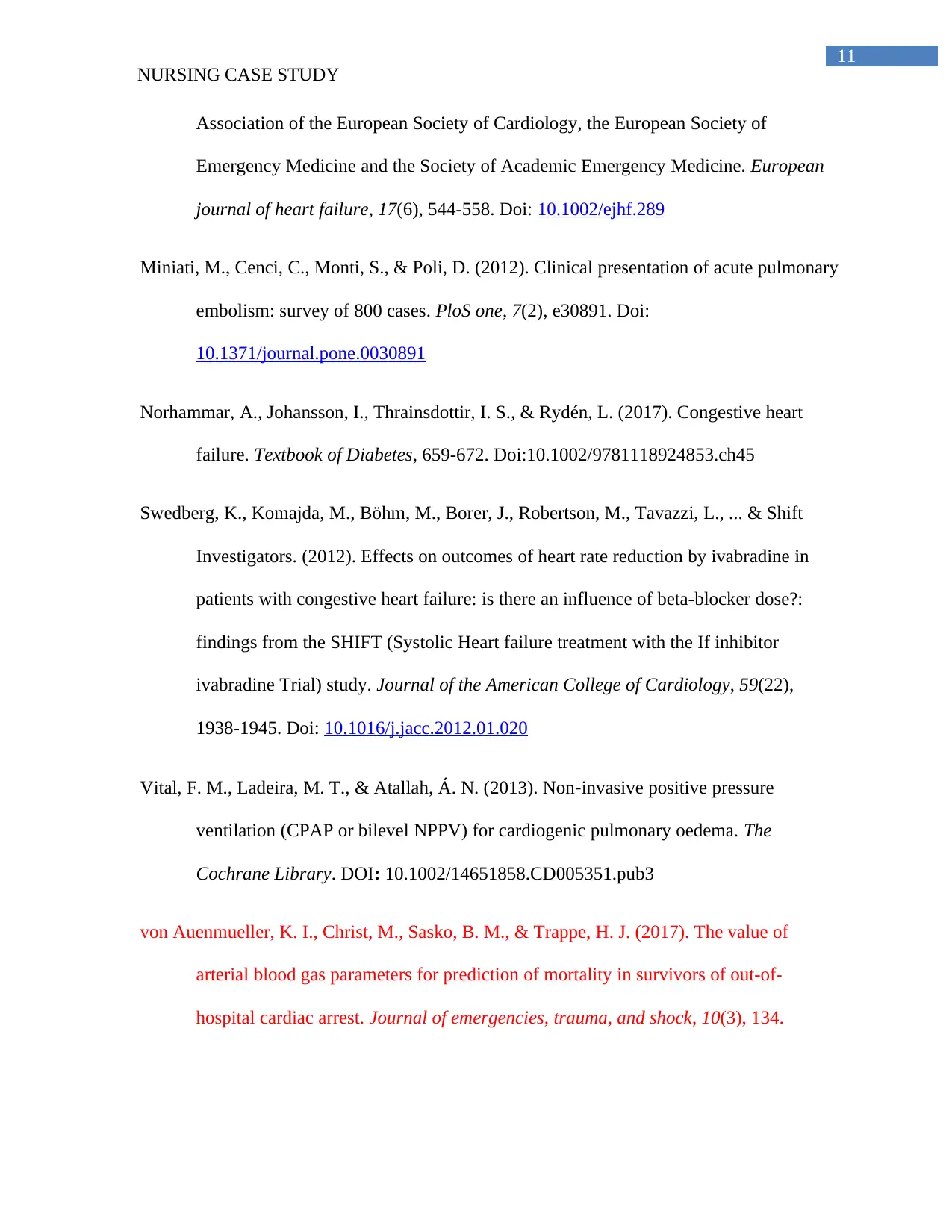
11
NURSING CASE STUDY
Association of the European Society of Cardiology, the European Society of
Emergency Medicine and the Society of Academic Emergency Medicine. European
journal of heart failure, 17(6), 544-558. Doi: 10.1002/ejhf.289
Miniati, M., Cenci, C., Monti, S., & Poli, D. (2012). Clinical presentation of acute pulmonary
embolism: survey of 800 cases. PloS one, 7(2), e30891. Doi:
10.1371/journal.pone.0030891
Norhammar, A., Johansson, I., Thrainsdottir, I. S., & Rydén, L. (2017). Congestive heart
failure. Textbook of Diabetes, 659-672. Doi:10.1002/9781118924853.ch45
Swedberg, K., Komajda, M., Böhm, M., Borer, J., Robertson, M., Tavazzi, L., ... & Shift
Investigators. (2012). Effects on outcomes of heart rate reduction by ivabradine in
patients with congestive heart failure: is there an influence of beta-blocker dose?:
findings from the SHIFT (Systolic Heart failure treatment with the If inhibitor
ivabradine Trial) study. Journal of the American College of Cardiology, 59(22),
1938-1945. Doi: 10.1016/j.jacc.2012.01.020
Vital, F. M., Ladeira, M. T., & Atallah, Á. N. (2013). Non‐invasive positive pressure
ventilation (CPAP or bilevel NPPV) for cardiogenic pulmonary oedema. The
Cochrane Library. DOI: 10.1002/14651858.CD005351.pub3
von Auenmueller, K. I., Christ, M., Sasko, B. M., & Trappe, H. J. (2017). The value of
arterial blood gas parameters for prediction of mortality in survivors of out-of-
hospital cardiac arrest. Journal of emergencies, trauma, and shock, 10(3), 134.
NURSING CASE STUDY
Association of the European Society of Cardiology, the European Society of
Emergency Medicine and the Society of Academic Emergency Medicine. European
journal of heart failure, 17(6), 544-558. Doi: 10.1002/ejhf.289
Miniati, M., Cenci, C., Monti, S., & Poli, D. (2012). Clinical presentation of acute pulmonary
embolism: survey of 800 cases. PloS one, 7(2), e30891. Doi:
10.1371/journal.pone.0030891
Norhammar, A., Johansson, I., Thrainsdottir, I. S., & Rydén, L. (2017). Congestive heart
failure. Textbook of Diabetes, 659-672. Doi:10.1002/9781118924853.ch45
Swedberg, K., Komajda, M., Böhm, M., Borer, J., Robertson, M., Tavazzi, L., ... & Shift
Investigators. (2012). Effects on outcomes of heart rate reduction by ivabradine in
patients with congestive heart failure: is there an influence of beta-blocker dose?:
findings from the SHIFT (Systolic Heart failure treatment with the If inhibitor
ivabradine Trial) study. Journal of the American College of Cardiology, 59(22),
1938-1945. Doi: 10.1016/j.jacc.2012.01.020
Vital, F. M., Ladeira, M. T., & Atallah, Á. N. (2013). Non‐invasive positive pressure
ventilation (CPAP or bilevel NPPV) for cardiogenic pulmonary oedema. The
Cochrane Library. DOI: 10.1002/14651858.CD005351.pub3
von Auenmueller, K. I., Christ, M., Sasko, B. M., & Trappe, H. J. (2017). The value of
arterial blood gas parameters for prediction of mortality in survivors of out-of-
hospital cardiac arrest. Journal of emergencies, trauma, and shock, 10(3), 134.
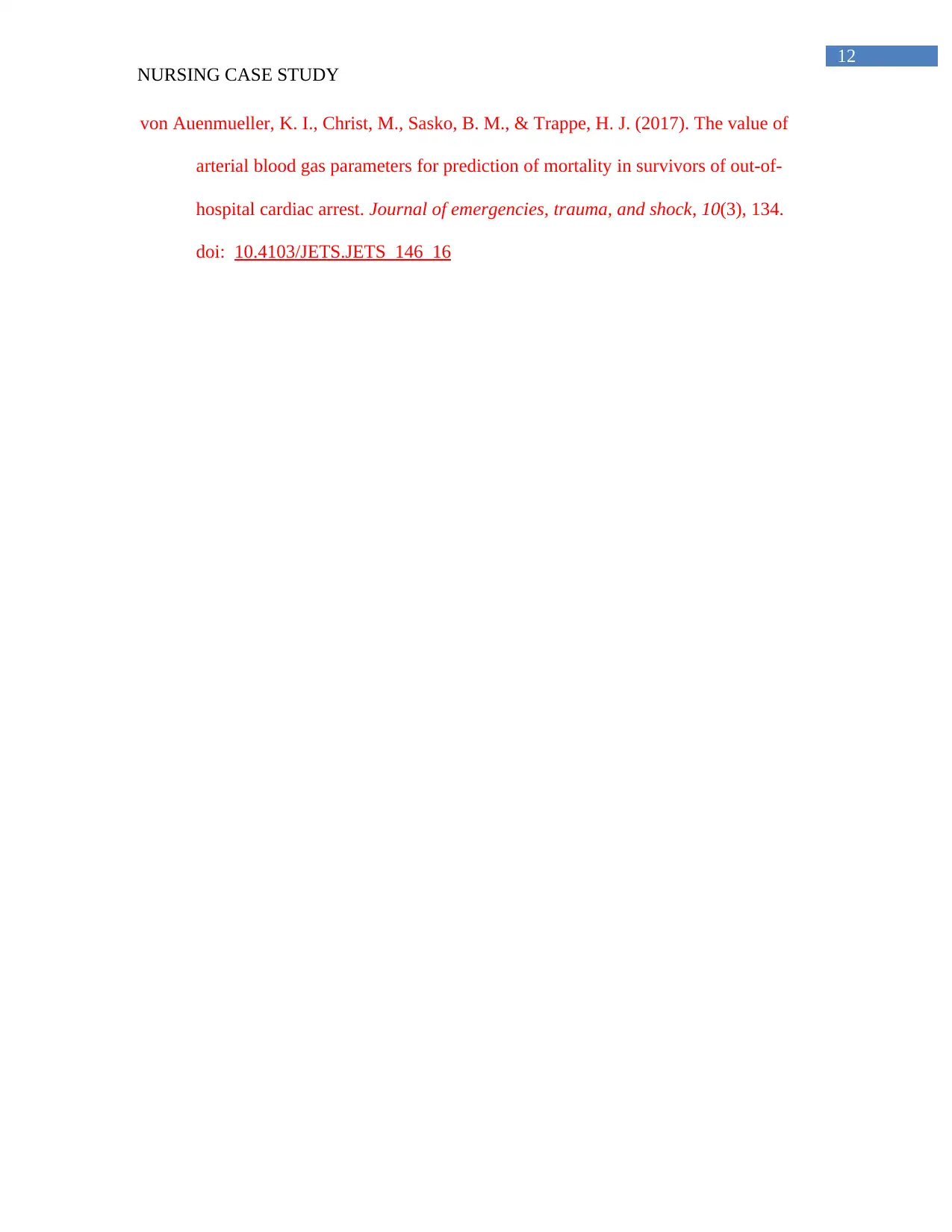
12
NURSING CASE STUDY
von Auenmueller, K. I., Christ, M., Sasko, B. M., & Trappe, H. J. (2017). The value of
arterial blood gas parameters for prediction of mortality in survivors of out-of-
hospital cardiac arrest. Journal of emergencies, trauma, and shock, 10(3), 134.
doi: 10.4103/JETS.JETS_146_16
NURSING CASE STUDY
von Auenmueller, K. I., Christ, M., Sasko, B. M., & Trappe, H. J. (2017). The value of
arterial blood gas parameters for prediction of mortality in survivors of out-of-
hospital cardiac arrest. Journal of emergencies, trauma, and shock, 10(3), 134.
doi: 10.4103/JETS.JETS_146_16
1 out of 13
Related Documents
Your All-in-One AI-Powered Toolkit for Academic Success.
+13062052269
info@desklib.com
Available 24*7 on WhatsApp / Email
![[object Object]](/_next/static/media/star-bottom.7253800d.svg)
Unlock your academic potential
© 2024 | Zucol Services PVT LTD | All rights reserved.





